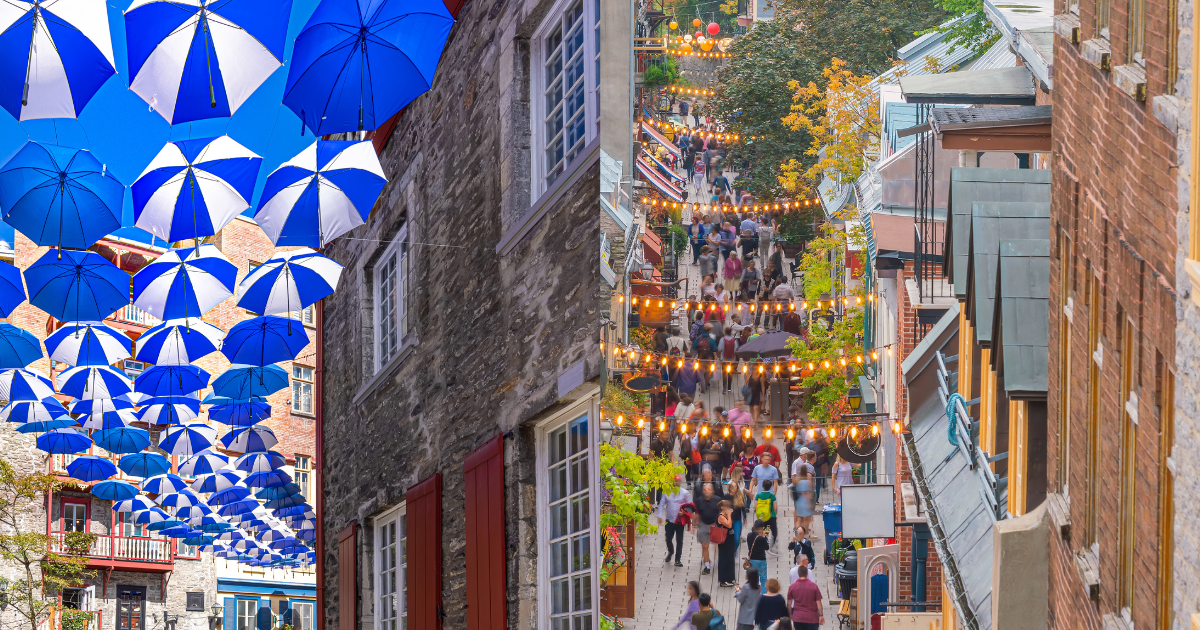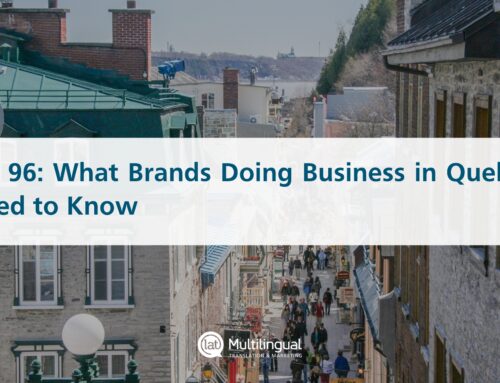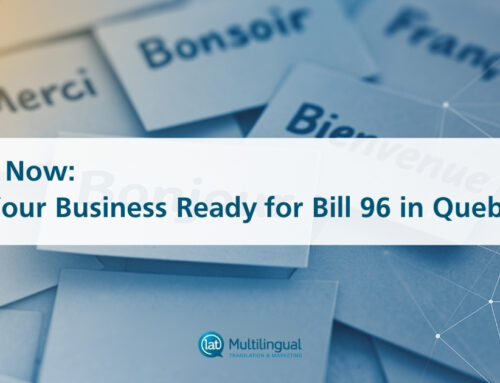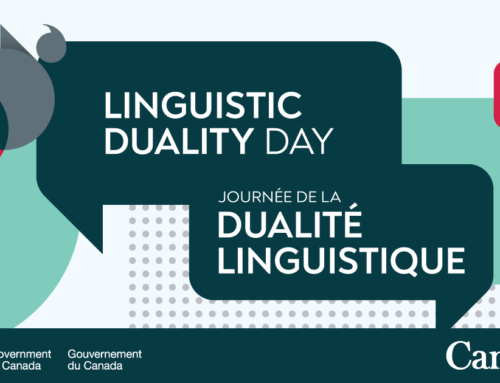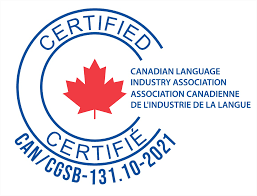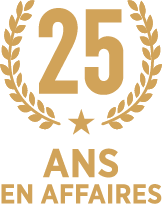French Canada has a rich and vibrant cultural history embedded in Québécois French – and the lives of the people who speak it. Preserving Québécois heritage is one of the main reasons the Canadian government has maintained language laws for businesses in Québec for the past 40 years.
But marketing to Québécois should go beyond just meeting legal requirements. A successful marketing campaign should speak to the unique culture of Quebec consumers as well as speak French.
Below are some ways Québécois culture is unique, and what that means for brands wanting to appeal to Québec consumers.
Québécois French is different than Metropolitan French.
Québec has its own colloquialisms, terminology and grammar that are different from Metropolitan French, due to its history and proximity to English speakers. French settlers arrived in Canada in 1535, and their isolation from France meant that the French language in Canada developed differently than it did in France, where there was often less reluctance to adopt English words into everyday French. Examples abound: ‘shopping’, ‘bus’, ‘’email’ ‘selfie’, ‘le pull’, and lots more. Thanks to Quebec’s insistence on preserving the French language from the flood of English expressions in everyday life, the province provides equivalent terms for each emerging trend. So Quebec uses courriel (for email), magasiner (for shopping), égoportrait (for selfie), etc.
You will also hear colloquial expressions that are unique to Québec and may be quite different from the French you’ll hear in Paris. For example, Québécois might say “aweille” instead of “allez” (go on) or use “lâ” as a verbal placeholder – while in Metropolitan French, “lâ” means “there.” Common names for some items – like “coton ouaté” for “hoodie,” are unique to French Canada. Consulting Quebec’s terminology databases is the key to ensuring the terms used in your marketing content are approved by the Quebec language office (Office de la langue française).
Brands need to be careful when localizing digital content for French Canadians. SEO optimization may fail if you’re optimizing for Metropolitan French terms instead of French Canadian terms.
Québécois can be protective of their language.
As in France, anglicisms are a trend to reckon with and in Québec, that can be contentious. A recent government ad campaign warned Québécois that these phrases endanger the French language – and while 77.5% of Québécois speak French at home, the dwindling numbers are a cause of concern.
However, concerns about the loss of Québécois culture are mixed; some speakers think that anglicisms broaden the expressive potential of the province’s French, while others worry that it signals the erosion of their culture.
Brands should be aware of this tension when creating marketing messages. In addition to following Québec’s language requirements on consumer goods, it is important to be cautious about the use of English words in brand messaging, even if they’re common in colloquial Canadian French.
Québécois culture is progressive and artistic yet rooted in tradition.
One of the unique paradoxes of Québécois culture is that it’s traditional yet progressive at the same time. Québec has a rich heritage with some of the oldest landmarks in Canada, along with a thriving literary and arts scene that has given rise to performing troupe Cirque du Soleil and graphic novel publisher Drawn and Quarterly.
Québecois consumers tend to shop in boutique stores, with an appreciation for fine dining and cutting-edge fashion – but the province is also a hub of traditional Canadian staples like poutine, hockey, and some of Canada’s finest craft breweries.
A lack of cultural integration was one of the important reasons big-box chain Target failed in Quebec, as the assumptions they made about shopping habits didn’t fit in with the culture. Brands should bring an awareness of the culture to their campaigns in Québec to understand what aspects of their brand will work in French Canada and what will fall flat.
How to hit the right note when marketing to Québécois consumers
Hitting the right note in Québec can be challenging for businesses that aren’t familiar with its complex culture. Here are a few examples of brands that missed the mark – and a few that got it right.
Missed the mark: MDC Canada
MDC Canada’s ad marked French as a downside to moving to Québec – which French Canada took particular offence, given their ongoing struggle to preserve their language. The ad was taken down, but the brand’s reputation was hurt.
The takeaway? It’s important to bring cultural awareness to ad campaigns across Canada, especially those targeting Quebec audiences.
Missed the mark: Columbia Sportswear
New Columbia Sportswear ad in Quebec lost in translation? | Watch News Videos Online
Columbia Sportswear’s slogan “soyez la chèvre” was a translation of its English slogan “Be the goat” – which fell flat in Québec.
There was speculation that the confusion stemmed from the fact that G.O.A.T. can stand for “Greatest Of All Time” in English but doesn’t have the same connotation in French, although a spokesperson denied that this was the original intent of the English version.
In any case, it’s evidence that some slogans just won’t work if they’re translated directly from English to French. Rather, brands should edit their slogans to fit the culture.
Hit the right note: Diageo
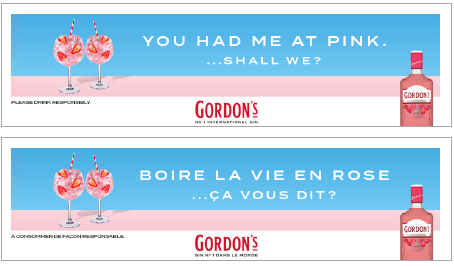
Diageo created bilingual campaigns for both French and English-speaking audiences with the help of LAT Multilingual to tailor marketing content to both languages.
The French version of their Pink gin’s slogan roughly translates to “drink life in pink.” The phrase “la vie en rose” refers to rose-coloured glasses in French, so there’s an underlying metaphor about looking on the bright side of life as well.
This campaign showcases how rewriting slogans can make them more powerful, drawing on common turns of phrase in native languages to give them a fresh impact.
Hit the right note: Budweiser
This ad was part of a Super Bowl campaign that featured NHL star Mike Bossy and Soucy Baron, the company that makes pucks for the NHL located in St-Jerome, Québec.
Hockey players and hockey fans signed the pucks and sent them to the company, which were made into a sign celebrating St-Jerome as the “City of Goals.” The mayor liked the slogan so much that he adopted it as the city’s slogan.
This experiential campaign tapped into an important part of Québec’s culture and history to give the American beer label a boost in a competitive Canadian market. It tied together the economic and cultural importance of hockey to the beer brand, which Québécois consumers might drink at a hockey game.
Localizing brand messages for Québécois consumers
If you’re looking for a way to connect with Québécois consumers, you’ll have to look beyond language to tap into the unique and rich culture of French Canada. Fortunately, LAT Multilingual’s Québec specialists are here to help you with your next campaign.
Reach out to learn more about how we can help you create localized brand campaigns in Québec.

